By Bryan Jáuregui, Todos Santos Eco Adventures
This article first appeared in Janice Kinne’s Journal del Pacfico.
It takes a fair degree of faith in the goodness of your fellow man to hitchhike… with a mule. But that is exactly what Trudi Angell and her daughter Olivia did as part of La Mula Mil, their 1,000 mile mule trip up the Baja Peninsula. One of their mules had taken a respite with friends along the way, and when it came time for him to rejoin the rest of the expedition – now many miles away – Trudi and Olivia just set out along the road with him. Women and mule were picked up by a rancher with a partially empty horse trailer in a matter of minutes, and safely delivered to their camp. Says Trudi, “This was indicative of the type of reception we got from ranch families throughout the entire expedition. They were above and beyond hospitable and helpful. Wonderful meals for us, care for the mules, information on trails – they were generous to a fault with all these things.”
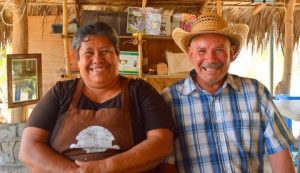
Doña Luz and Don Cata
Fermín Reygadas, a professor of Alternative Tourism at the Autonomous University of Baja California Sur (UABCS) who has worked with Baja California rancheros for over 30 years, is not at all surprised. “The Baja ranchero culture of hospitality is directly connected to the old Bedouin custom that demanded the utmost in hospitality, requiring you to give aid and succor to anyone who asked for it for at least 3 days, even if that someone was your mortal enemy. Of course, you were free to kill him after that, but for those 3 days he was an honored guest in your home.” Bedouins?
Fermín explains. “When Padre Kino first arrived with the Jesuits in Baja California in 1683, pirates were a menace to this new territory of Spain. Padre Kino sold the Spanish king on the idea of Jesuits settling the land and using their own money and means to keep it free of pirates. In return, the Jesuits would have the right to rule without interference from a Spanish-run civil government. The king agreed and the Jesuits set about recruiting soldiers that bore little resemblance to their European counterparts. They didn’t choose people based on their fighting or weaponry skills, but rather people who knew how to raise cattle and plant crops. They didn’t choose typical soldiers looking for new world get-rich-quick schemes, but people seeking a living from the land with a focus on family. The Jesuits chose people whom they considered honorable, trustworthy and capable to protect and settle Baja California Sur.” In short, they chose the people whose descendants make it possible for women to successfully hitchhike around the peninsula with a mule. We’re getting to the Bedouins.
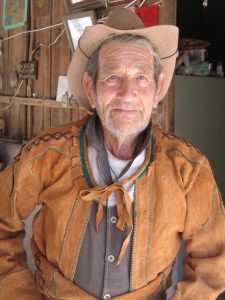
Miguel Martinez. Photo by McKenzie Campbell, Living Roots
Fermín continued, “When the Jesuits arrived in Baja California the indigenous peoples here were hunter-gatherers, skills not suited to building a permanent society. So the Jesuits looked for people who had the ranching and farming skills that could support their missions. These people came from two main sources: 1) people from the agricultural province of Andalusia in Spain, which had been heavily settled by Moors, Arabs and Middle Easterners during the Moorish conquest of Spain in the 8th to 15th centuries, and 2) descendants of the Moors, Arabs and Jews who had been kicked out of Spain during the 15th century Christian reconquest of the country, and had settled in the new world. Not only did these “soldiers” carry the Bedouin tradition of hospitality and honor, they brought Middle Eastern foods to the Baja Peninsula that still flourish to this day including olives, grapes, lentils, date palms and alfalfa.” Teddi Montes, a member of La Mula Mil expedition, took DNA samples from rancheros throughout the trip and her preliminary results show that these middle eastern bloodlines are still found throughout the peninsula, i.e., the Bedouins – along with their hospitality – are alive and well in Baja California!
Ranchero Rule in BCS
The Jesuits ended up being entirely too successful for their own good with their BCS economic model, and they were unceremoniously kicked out of Baja in 1768. The king sent a new administrator who gave the Jesuit mission lands to the “soldiers” who had been working the land under the Jesuits. By this administrative fiat a whole new class of fairly egalitarian land ownership arrived in BCS, and a system of ranches owned and operated by people with excellent skills, a strong work ethic, and a tradition of honor flourished. This was in stark contrast to mainland Mexico, which was heavily settled by Spanish hidalgos, the 2nd, 3rd and 4th sons of wealthy marquis who could not inherit the ancestral lands back home, but who could help themselves to substantial holdings in the new world. “Work ethic” was not a phrase commonly used when speaking of the privileged hidalgos.
By the late 1800s the Baja economy had become centered around mining, with major gold, silver and copper mines flourishing in towns like Santa Rosalia
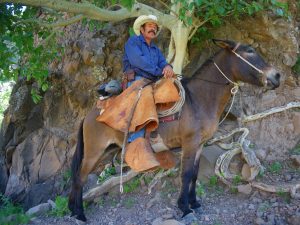
Chema. Photo by McKenzie Campbell, Living Roots
and El Triunfo. As mining prospered, so did the ranches that supplied them with food, leather goods, horses, mules, and coffee. Mainland Mexico, focused on its own affairs – including wars with the US and France – paid very little attention to Baja for the next 100 years. The result was that the BCS character cultivated by the Jesuits and strengthened by land ownership was left intact, and continued to develop almost completely independently of the rest of Mexico. While mainland Mexico society became highly stratified, Baja California remained a much more egalitarian, independent-minded place, with ranchero families a key and integral part of the peninsula’s economy.
Then mining collapsed in the 1950s, and the ranchero economy went into a tailspin. But the deathblow really came in 1975 when the Mexican government opened its previously closed economy to the outside world. Two territories were declared free ports open to foreign trade: Quintana Roo and BCS. Almost overnight the market for ranch meats, cheeses and leather goods dried up; imported goods could be bought more cheaply and easily in the cities. Ranchero culture was in peril, and made all the more precarious by a school system that requires ranch children to leave home for 9 years and live in boarding houses in towns like Todos Santos, where they steadily lose touch with their culture. As Fermín says, “They watch a lot of TV in the boarding houses, and if their culture doesn’t appear on TV, then they assume it’s not important.” Fermín, Trudi, Olivia and others are trying very hard to change that perception.
Living Roots
In 2008 a documentary titled Corazon Vaquero – Heart of the Cowboy – won the Paso Robles Film Festival California Roots award. Created by Garry and Cody 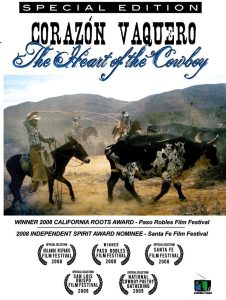 McClintock and Eve Ewing with Trudi, Fermín and others to showcase the beauty of BCS ranchero culture, the film is centered largely around a family at Rancho San Gregorio in the Sierra de la Giganta above Loreto. In the spring of 2008 a young NOLS instructor named McKenzie Campbell found herself at that same ranch. “I learned how to do leatherwork, make cheese, all kinds of things. I was completely enamored. I then did a week-long scouting trip through the Sierra de la Giganta walking ranch to ranch, and I was completely blown away by the hospitality of the people and their values. They are focused on family, their land and working hard for themselves. They don’t need a lot to be happy. They inspired me to go back to school to get the tools to aid them in the transition to the modern world, to participate in the larger market around them.”
McClintock and Eve Ewing with Trudi, Fermín and others to showcase the beauty of BCS ranchero culture, the film is centered largely around a family at Rancho San Gregorio in the Sierra de la Giganta above Loreto. In the spring of 2008 a young NOLS instructor named McKenzie Campbell found herself at that same ranch. “I learned how to do leatherwork, make cheese, all kinds of things. I was completely enamored. I then did a week-long scouting trip through the Sierra de la Giganta walking ranch to ranch, and I was completely blown away by the hospitality of the people and their values. They are focused on family, their land and working hard for themselves. They don’t need a lot to be happy. They inspired me to go back to school to get the tools to aid them in the transition to the modern world, to participate in the larger market around them.”
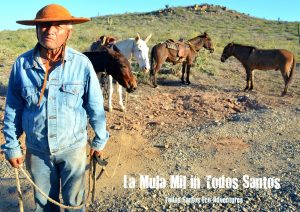
Carlos Ignacio (Nacho) Chiapa with La Mula Mil in Todos Santos
Two years and one MBA later, McKenzie returned to BCS and founded Living Roots, a non-profit with the mission of “Helping an endangered culture adapt and thrive in the modern world.” Focusing on San Javier, the site of one of the Jesuits’ very first missions in BCS, McKenzie set about walking the delicate line between protecting ranchero values and traditions, while connecting ranchero families directly to the marketplace. “They grasped immediately that they had a brand-able concept, but they didn’t see that some of their every day items like ropes and jackets had market value, and we were able to help them see and capture some of that value.” In 2013 Living Roots helped the rancheros establish a cultural center in San Javier that connects them directly with their public. Not only does this place serve as a market for ranch products, but it’s now the base station for many young rancheros who are being trained as guides in order to lead interpretive hikes around the area. In 2014 Living Roots and its ranchero partners also started a farmer’s and artisan’s market in Loreto that sells organic produce, fish and handicrafts. Says McKenzie, “The US and Canadian communities who live in Loreto are hungry for local produce so it’s been quite successful. It is wonderful to see it all progressing so well.”
McKenzie’s next goal for Living Roots is to start a school for young rancheros aged 15-25 where they can learn the old technologies and merge them with the new. Courses are already underway in some schools, with living legends like Dario Higuera, featured prominently in Corazon Vaquero, teaching traditional leatherwork to kids in the local schools. The most popular items to make are wallets and cell phone covers.
Into the Future
35 year-old Rogelio Rosas knows the value of learning traditional skills from his ranching elders. As a child he lived with his grandparents on the family ranch in San Dionisio in the Sierra de la Laguna mountains. Every day he would work alongside his grandfather, learning how to identify and use the 80 edible wild
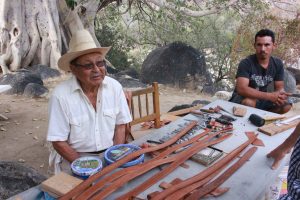
Don Claudio teaching leatherwork. Photo by Eduardo Boné
plants that grow in BCS, including those with medicinal properties. By the time he was 10 he was helping his grandfather deliver babies and heal the sick throughout the area. When his grandfather died at the age of 116 (leaving 35 children fathered with 5 wives) Rogelio felt compelled to enroll at a seminary in Tijuana. But he didn’t find the answers he expected there, so he joined up with some missionaries and spent the next 6 years traveling throughout Baja, using the healing arts learned from his grandfather to help children around the peninsula.
Rogelio found this work rewarding, but he still wasn’t finding the answers he was seeking. So at the age of 28 he moved to La Paz to study philosophy at UABCS, the first member of his family to attend college. While there, he met McKenzie and Fermín who were in the alternative tourism arena, so he added tourism to his list of degrees. By this time Rogelio’s parents, the now-legendary Don Catarino and Doña Luz, had been living at the family ranch for many years, making a very nice living with their organic produce, leather work and other traditional skills. When Doña Luz suffered a snake bite that paralyzed half her body, Rogelio returned to the ranch where he had grown up to help her. By the time he graduated with his double degree from UABCS, he could have joined the majority of his ranching peers and gone off to seek employment in a shinier part of the economy. But he found the pull of the ranch impossible to resist, and is now working with his parents to develop their ranch as a tourist destination where visitors can learn about traditional crafts like leatherworking and cheese-making, hike to see waterfalls and rock art, learn about traditional medicinal herbs, make tortillas from scratch, and enjoy the
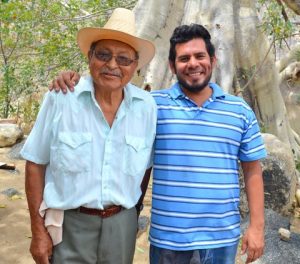
Don Claudio and Rogelio
history and culture of the area. This is the future that he sees that will sustain not only his family’s ranch, but those of other families throughout the region.
But like Fermín, Trudi and McKenzie, Rogelio’s real passion is to preserve the heart and soul of ranchero culture. To that end he has created a document that sets forth the principals and values of ranchero life. Working with seven other sons of ranchers who, like him, left home for a while but then returned, he is in the process of creating an association that will keep the rancheros of the Sierra de la Laguna mountains united and focused, adapting to a changing world economy as necessary to thrive, but doing so while maintaining the values and ethics of their forebears, handpicked by the Jesuits. The goal is to remain true to their Bedouin roots. You can count on their hospitality.
